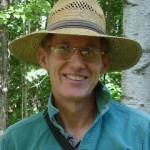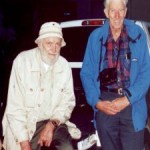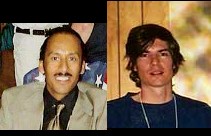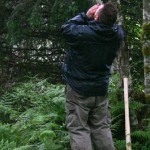
April 24, 2010
Why do people exit the stage after spending a bit of time in the pursuit of Bigfoot, Sasquatchery, and hominology?
Needless to say, there are many reasons. There may be too many to cover today, but let’s look, for a moment, at this exit scenario.
First, a bit of breaking news that some may have heard, and others, who wait for the weekend, may be catching up to.

Bigfoot blogging lost another one this week. It is quite the buzz on the Internet that D. B. Donlon (shown above, with a furry friend) decided to leave the field with his announcement that surprised many, over at The Blogsquatcher.
As the Anomalist summarized it: “Into the Sunset The Blogsquatcher ~ The search for the answers to the mystery known as Bigfoot is coming to an end for The Blogsquatcher, according to his latest post….DB Donlon gives his reasons for abandoning a quest to bring meaning to the mystery of Bigfoot. He will be missed.”
In his own words, Donlon states it flatly: “There comes a time when all things must change, when our interests transform, and our needs become different. That time has come for me in respect to this blog. I have enjoyed the journey that this blog represents, but my friends, I must tell you, it is done.
“In fact, I am now retired from looking for bigfoot in any capacity from here out. For me, bigfoot has become not less of a mystery since I started looking into it in 2004, but much, much more mysterious. I despair of actually ever discovering what lies at the bottom of the matter.
“But whether or not that is the case, I have exhausted the energy I have to spend upon it.”
[Historical footnote: Yours truly, Loren Coleman coined the term “blogsquatching” on the Internet, at the Cryptomundo blog, on November 25, 2006, in a posting I was writing about the origins of the word “blobsquatch.” See here. I said then that “this new term is the use of web logs to spread information on unknown hairy hominoids such as Sasquatch, Yeti, and Yowie across the internet.” D. B. Donlon took me to heart, and took on the word, literally, for his blog.]
Donlon mentions having been hunting Bigfoot since 2004, but, specifically, his blog began at 8:28 AM, on Thursday, October 4, 2007.
He wrote:
“A new blog rises
I’ll make this first post a short and sweet mission statement. I plan to post original work here having to do with bigfoot research. You might occasionally find links here to whatever the “bigfoot outcry of the day” seems to be, but I’m not going to focus on that. (For that sort of thing you can easily go to cryptomundo.) I want to instead dig into the deeper levels of sasquatch research. So in a lot of ways, this will be a ‘meta’ blog. But I will also detail whatever I’m finding in my own research. I have quite a few things planned already….”
It is intriguing that right before Donlon left the field, he explored the paranormal side of things, to find some answers. I’ll won’t go into this, psychologically, because I don’t wish to be misunderstood. But I do internalize this and understand that the process for some comes out of being frustrated in looking for concrete answers. It is a natural progression of the intellectual process, as humans explore all kinds of avenues in trying to find the keys to their questions, as well as the answers themselves.
Do not misread me. I am not placing judgments and different values on these different paths. Certainly, the validity of the search rings true for many, and the various paths to be explored need to be supported and reinforced by all of us (save for the ones that lead down roads of greed, fakery, and destruction – those evil pools of quicksand, indeed).

I am reminded, in reading of D. B. Donlon’s recent musings, of the similar journey many of us have watched Mac Tonnies and his friends and followers take. Mac Tonnies, 34, a rising intellectual presence in Fortean thought, the “Posthuman Blues” blogger, never got to see his The Cryptoterrestrials (2010), published to grand reviews and hot sales. Sadly, he left the scene before he could put all the pieces together. He was found dead in his apartment on Thursday afternoon, October 22, 2009. People, as I mentioned, leave the field in many ways.
Tonnies was covering the same ground many others had before, but, although this often was not acknowledged by him, he may not have been intentionally ignoring previous thinkers. In many ways, Tonnies had found a way to view Bigfoot and the other minions by going along a different path to end up, intellectually, with youth, at a place similar to Donlon’s. I know, because I wandered in that forest with Jerome Clark, once upon a time. I have never denied that. Donlon, despite his “last sunset” posting, however, is not dead and still survives to think tomorrow. That is an important and significant difference from those who leave due to death. The end is so final that way.
Nevertheless, some people make wonderful homes for their thoughts in the occult, paranormal, Jungian, or spiritual forests, like Jacque Vallee. Even others find it creepy and scary, like John A. Keel, and yet still may remain inside their own dark woods.

Others take detours and decide to go other places. The tale of Jim McClarin is known to many. He was very intrigued by Bigfoot, intensively interested in the field work and early computer research, and will forever be known as the guy that stood in for Bigfoot in John Green’s post-Patty film at Bluff Creek. Jim also will be remembered for his statue at Willow Creek. He’s still a friend, personally to me, and yet he left the field (or so he thought) in 1975, to become a survivalist, then later a politician, and today, an insect photographer.

A similar person many of us knew in the 1990s was thought by everyone to be the next leading light in Sasquatch research. Instead, here is how Kyle Mizokami (shown above, still hiding? today) writes about himself on WordPress in 2010, where he is still blogging about things that catch his fancy: “Kyle majored in history at San Francisco State University. Among his many jobs he has worked reviewing x-rated web sites, at an arms and armor auction house selling guns, and in a fortune cookie factory. Kyle once spent five years chasing Bigfoot, whom he did not catch.”
Who are any of us to say when the time is or isn’t right for people to go elsewhere in their lives?
Various former Bigfooters have left after marriage, when having kids, due to moving, when they changed jobs or became academics. All of these may seem like mundane choices. But to each of these people, it may have turned into the right ones for them.
Some have departed the field because the phenomena got too close to them. They believed their contact with Bigfoot, for example, gave them insights that told them to save Sasquatch, that they had to abandon the search. Others have felt their positions – in their colleges or their marriages – would be jeopardized if they stayed on the hunt.
A random few have felt betrayed by Bigfoot and Bigfoot hunters, due to the sense of false promises of immediate discovery or the terrible human interactions with hoaxers and fakers.
The Bigfoot research field is no different than any other, but, then again, we are seen as very dissimilar by most people.

Besides merely passing this way, some people do pass away. But people like Grover Krantz have given a lot, just like Tonnies, no matter their age, no matter their tenure, before they die.


In many ways, when you look at it, it is really amazing that there are people like me, John Green, Daniel Perez, Jeff Meldrum, Matt Moneymaker, Scott McClean, and many others who are still around – despite how people might feel about any of us personally. Or how any of us think about each other. 🙂

Goodbye, D. B. Yes, you will be missed, but I am reminded of a California employer who once hired me for a job before I left his first interview. What he said to me was this: “I’d rather have the absolutely best person I could get for one year of work, than have someone who is half as good who will promise to stay and work for me for ten years.”
When hunting, researching and being interested in Bigfoot, there are many reasons for departing from the field. Likewise, there are many levels of appreciation for the fact that partners in our pursuit have stayed on the trail even for a year or decades.
About Loren Coleman
Loren Coleman is one of the world’s leading cryptozoologists, some say “the” leading living cryptozoologist. Certainly, he is acknowledged as the current living American researcher and writer who has most popularized cryptozoology in the late 20th and early 21st centuries.
Starting his fieldwork and investigations in 1960, after traveling and trekking extensively in pursuit of cryptozoological mysteries, Coleman began writing to share his experiences in 1969. An honorary member of Ivan T. Sanderson’s Society for the Investigation of the Unexplained in the 1970s, Coleman has been bestowed with similar honorary memberships of the North Idaho College Cryptozoology Club in 1983, and in subsequent years, that of the British Columbia Scientific Cryptozoology Club, CryptoSafari International, and other international organizations. He was also a Life Member and Benefactor of the International Society of Cryptozoology (now-defunct).
Loren Coleman’s daily blog, as a member of the Cryptomundo Team, served as an ongoing avenue of communication for the ever-growing body of cryptozoo news from 2005 through 2013. He returned as an infrequent contributor beginning Halloween week of 2015.
Coleman is the founder in 2003, and current director of the International Cryptozoology Museum in Portland, Maine.
Filed under Bigfoot, Breaking News, Cryptomundo Exclusive, CryptoZoo News, Cryptozoology, Men in Cryptozoology, Pop Culture, Sasquatch, Skunk Apes, Swamp Monsters, Windigo, Women in Cryptozoology